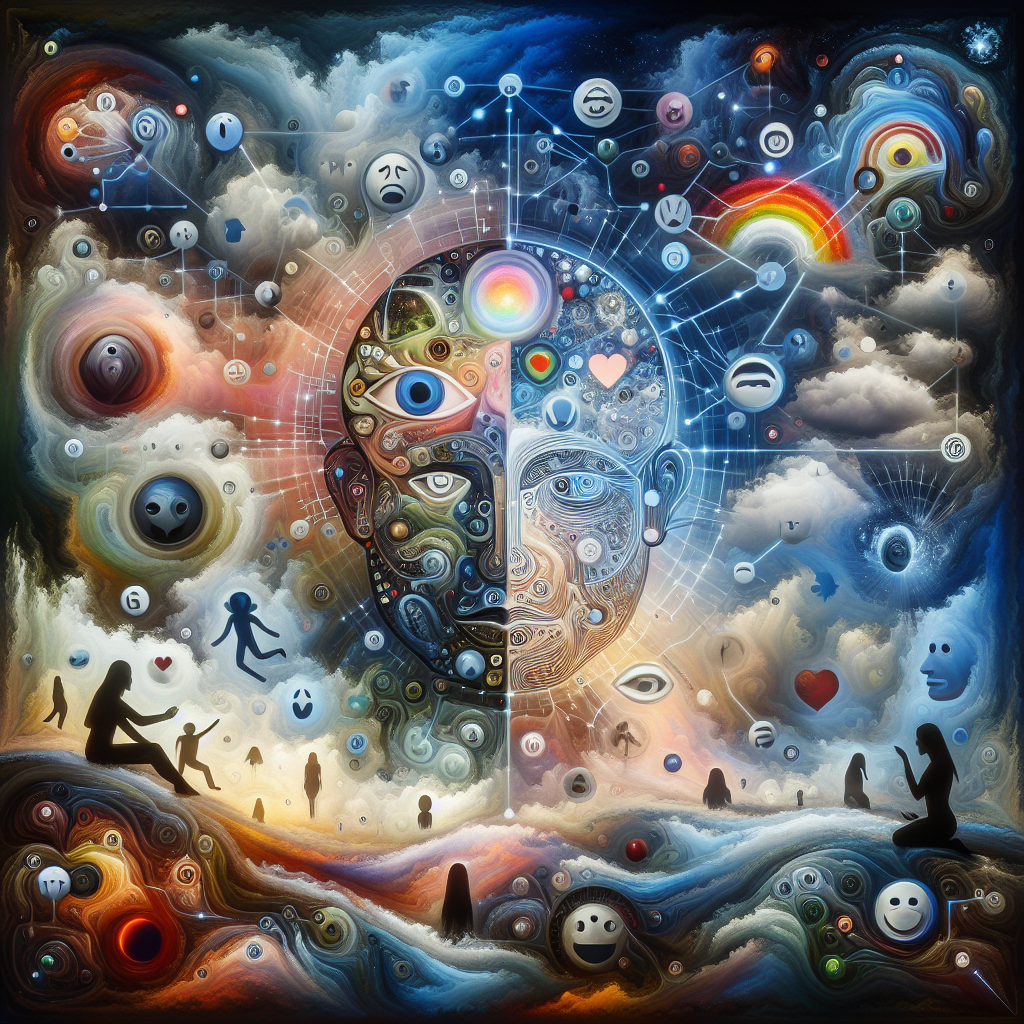Have you ever wondered which emotion is most common amongst all the different human emotions that we experience? From joy to sadness, anger to fear, the spectrum of emotions is vast and complex. Understanding the most prevalent emotion can provide valuable insights into the human psyche and how we navigate through life. In this article, we will explore the question of what emotion is most common and delve into its significance in our everyday lives. So, let’s embark on this fascinating journey and uncover the answer together.

Understanding Emotions
What are emotions?
Emotions are complex psychological and physiological experiences that occur in response to various stimuli and events. They often involve subjective feelings, bodily sensations, and behavioral responses. Emotions can range from simple states like happiness and sadness to more complex ones like anger, fear, love, and surprise. They play a fundamental role in our lives, shaping our thoughts, actions, and relationships.
Why do we experience emotions?
Emotions serve essential functions in our lives. They help us navigate and make sense of the world around us. Emotions can provide valuable information about our well-being, relationships, and personal needs. They motivate us to take action, whether it’s seeking pleasure, avoiding danger, or connecting with others. Furthermore, emotions facilitate communication and social bonding, allowing us to express our inner states and understand the experiences of others.
How are emotions expressed?
Emotions are expressed through a combination of verbal and non-verbal cues. Non-verbal expressions, such as facial expressions, body language, and gestures, play a significant role in conveying emotions. For example, a smile can indicate happiness, while a furrowed brow may signal anger or frustration. In addition to facial expressions, vocal tones, and pitch, as well as changes in body posture and gestures, can also communicate specific emotions. These expressions vary across cultures to some extent, highlighting the influence of societal and cultural factors on emotional expression.
Research on Common Emotions
Methods of studying emotions
Researchers employ various methods to investigate emotions. These include self-report measures, where individuals rate their emotional experiences using questionnaires or scales. Psychophysiological measures, such as heart rate, skin conductance, and brain imaging techniques, provide insights into the physiological correlates of emotions. Behavioral observation, both in controlled laboratory settings and naturalistic environments, helps researchers understand emotional expressions and reactions in real-world contexts. By combining these methods, scientists can gain a comprehensive understanding of emotions and their underlying processes.
Factors influencing emotions
Emotions are influenced by a multitude of factors, including cognitive, biological, and environmental elements. Cognitive factors such as perception, interpretation, and appraisal of events play a crucial role in shaping emotional experiences. Biological factors, such as genetics and neurotransmitter function, contribute to individual differences in emotional responses. Additionally, environmental factors, such as culture, social norms, and personal experiences, significantly impact the expression and experience of emotions. Understanding these factors aids in comprehending the diversity and complexity of emotional experiences across individuals and societies.
The Most Common Emotion
Overview of common emotions
Numerous emotions shape the human experience. Some of the most common emotions include happiness, sadness, fear, anger, love, and surprise. Each of these emotions serves a unique purpose and has distinct effects on our thoughts, behaviors, and overall well-being.
Identifying the most prevalent emotion
While emotions vary depending on individual differences and unique circumstances, research suggests that happiness tends to be the most prevalent emotion among individuals. Happiness is associated with positive feelings, satisfaction, and well-being. It arises from a combination of genetic factors, life circumstances, and personal choices. Despite its subjective nature, happiness is a universal human desire that transcends cultural boundaries and societal differences.
Happiness: A Ubiquitous Emotion
Defining happiness
Happiness can be defined as a state of subjective well-being and contentment. It encompasses positive emotions, life satisfaction, and a sense of fulfillment. While happiness is often associated with external factors like accomplishments and material possessions, it primarily stems from internal states, attitudes, and perspectives.
Psychological perspective on happiness
Psychologists have extensively studied happiness and proposed theories on its determinants. One popular framework is the Subjective Well-Being (SWB) theory, which suggests that happiness is influenced by three key components: positive affect (experiencing positive emotions), negative affect (experiencing negative emotions), and life satisfaction (contentment with one’s life circumstances). Positive psychology, a branch of psychology dedicated to understanding human flourishing, emphasizes the importance of cultivating positive emotions, meaningful relationships, and personal strengths to enhance happiness.
Cultural and societal influences on happiness
While happiness is a universal aspiration, cultural and societal factors shape its expression and perception. Different cultures may prioritize certain aspects of happiness, such as individual achievement, communal harmony, or spiritual fulfillment. Additionally, societal norms and expectations can impact individuals’ pursuit of happiness, influencing their choices, values, and overall well-being. Understanding these cultural and societal influences provides valuable insights into the complexity and diversity of happiness as an emotion.

Sadness: A Universal Yet Diverse Emotion
Understanding sadness
Sadness is a universal human emotion characterized by feelings of sorrow, grief, and unhappiness. It often arises in response to loss, disappointment, or unfulfilled expectations. Sadness is a natural and necessary emotional response that allows individuals to process and cope with challenging life events.
Causes and triggers of sadness
Sadness can be triggered by various factors, including the loss of a loved one, failure, rejection, or the experience of negative life events. Personal circumstances, such as relationship difficulties or health problems, can also contribute to feelings of sadness. The intensity and duration of sadness may vary depending on individual coping styles, support systems, and the significance of the triggering event.
Cultural variations in experiencing sadness
Although sadness is a universal emotion, cultural norms and values can shape the expression and experience of sadness. Some cultures encourage individuals to openly express their sadness, seeking support and solace from others. In contrast, other cultures may expect individuals to suppress their feelings of sadness, emphasizing stoicism or the importance of maintaining a positive outlook. These cultural variations highlight the role of societal influences in shaping emotional experiences.
Fear: The Prevalence of an Evolved Response
Fear as a survival mechanism
Fear is an adaptive emotion that evolved to ensure our survival. It is triggered in response to potential threats or dangers and prepares us to either confront the threat or flee from it. Fear can be a brief, acute response to a specific stimulus or a persistent anxiety arising from uncertain or prolonged threats.
Cognitive and physiological aspects of fear
When confronted with a fearful situation, our body undergoes physiological changes known as the “fight-or-flight” response. This includes increased heart rate, heightened alertness, and the release of stress hormones, such as adrenaline. From a cognitive perspective, fear involves the appraisal of a situation as threatening and the interpretation of potential consequences. Additionally, fear can be influenced by learned associations, cultural influences, and individual differences in risk perception.
Social and cultural influences on fear
Fear is not only an individual experience but also shaped by social and cultural factors. Societal norms, media portrayals, and collective experiences can influence the perception and expression of fear. Cultural variations exist in terms of specific fears, as well as the extent to which fear is openly acknowledged and discussed. Understanding these influences is crucial for addressing and managing fear-related challenges at both the individual and societal levels.

Anger: The Complex Emotion
Exploring anger
Anger is a complex emotion characterized by feelings of displeasure, frustration, and the urge to retaliate. It can arise in response to perceived injustices, conflicts, or violations of personal boundaries. Anger serves as a signal that something is wrong and motivates individuals to protect their interests or address an issue.
Physiological and psychological effects of anger
Anger triggers a range of physiological responses, including increased heart rate, elevated blood pressure, and the release of stress hormones like adrenaline. From a psychological perspective, anger can influence cognitive processes, such as attention, memory, and decision-making. Uncontrolled or prolonged anger can have detrimental effects on physical and mental health, relationships, and overall well-being.
Cultural differences in expressing and experiencing anger
While anger is a universal emotion, cultural norms and expectations influence its expression and interpretation. Some cultures encourage individuals to openly express their anger as a means of resolving conflicts or asserting themselves. In contrast, other cultures may discourage overt anger expression, valuing emotional restraint or indirect communication. These cultural variations highlight the role of cultural conditioning in shaping anger-related responses and behaviors.
Love: The Universal Language of Connection
Defining love
Love is a multifaceted emotion encompassing feelings of intimacy, affection, care, and compassion. It plays a vital role in forming and maintaining interpersonal relationships, ranging from familial bonds to romantic partnerships. Love involves a deep sense of attachment and often motivates individuals to prioritize the well-being and happiness of their loved ones.
Types and manifestations of love
Love can be experienced and expressed in various ways. Familial love, like the bond between parents and children, is characterized by unconditional care and protection. Romantic love involves strong emotional and physical attraction, accompanied by feelings of passion and desire. Love also extends to friendships, where feelings of trust, loyalty, and companionship foster deep connections. The manifestations of love may differ across cultures and interpersonal contexts, reflecting diverse social norms and expectations.
Cultural and interpersonal factors influencing love
Cultural norms, beliefs, and values significantly shape the experience and expression of love. In some cultures, arranged marriages are common, emphasizing familial obligations and social compatibility. Other cultures prioritize romantic love as the foundation of intimate relationships. Additionally, individual personality traits, attachment styles, and past experiences influence how individuals give and receive love. Understanding these factors helps us appreciate the complexities and variations in the experience of love across individuals and societies.

Surprise: The Unexpected Emotion
Understanding surprise
Surprise is an emotion that arises when we encounter unexpected or unforeseen events or information. It involves a temporary disruption of our assumptions or predictions, leading to a heightened state of awareness and curiosity. Surprise can range from mild astonishment to intense shock, depending on the magnitude and significance of the unexpected event.
Cognitive and physiological responses to surprise
When surprised, our cognitive systems strive to make sense of the unexpected information and integrate it into our existing knowledge frameworks. The physiological responses to surprise can include widened eyes, increased heart rate, and heightened arousal. Surprise can also lead to changes in attention and memory processes, as our brain prioritizes information that is novel and unexpected.
Cultural and personality influences on surprise
Cultural and individual differences shape the experience and interpretation of surprise. Some cultures may embrace surprises as positive and exciting, fostering a sense of adventure and novelty. In contrast, other cultures may view surprises with caution or skepticism, emphasizing stability and predictability. Additionally, an individual’s personality traits, such as openness to new experiences, can influence their response to surprises. Understanding these influences helps us better understand how surprise contributes to our emotional repertoire.
Conclusion
Emotions are complex, diverse, and fundamental aspects of human experience. While happiness tends to be the most prevalent emotion, each emotion plays a unique role in our lives. Understanding the underlying mechanisms, influences, and expressions of emotions enhances our self-awareness, empathy, and overall emotional well-being. Factors like cognitive processes, biological predispositions, cultural norms, and personal experiences collectively shape the rich tapestry of human emotions. By recognizing the complexity of emotions, both individually and in societal contexts, we can cultivate healthier emotional lives and foster greater understanding and connection with others.


